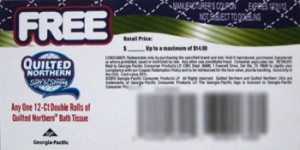 I know I’ve posted about this subject before, but we all need to be reminded of this from time to time. Obtaining and using fake/copied coupons is a serious crime. When a consumer uses a fraudulent coupon at a store and it is accepted, the store will NOT be reimbursed for that money. Once it gets to the coupon clearinghouse and flagged as fake, the store loses out on the money and couponers get a bad name.
I know I’ve posted about this subject before, but we all need to be reminded of this from time to time. Obtaining and using fake/copied coupons is a serious crime. When a consumer uses a fraudulent coupon at a store and it is accepted, the store will NOT be reimbursed for that money. Once it gets to the coupon clearinghouse and flagged as fake, the store loses out on the money and couponers get a bad name.
So here are a few tips to figure out if coupon is real or not:
Red Flags:
1. Word Doc: Coupons do NOT generally come in a Word Document. Some may come in a PDF doc, but I’ve never seen a legit coupon come in a Word Document.
2. High Value: An $8 Huggies sure sounds great..but like everything else in life, if it sounds too good to be true, it usually is. If in doubt, call the company to find out if they ever released the coupon.
3. Look for a hologram seal: Most FREE product coupons that are issued by manufacturers will contain a hologram seal somewhere on the coupon. If it does not have a seal, be suspicious.
4. No expiration date: If your coupon doesn’t have an expiration date or one that last longer than 6 months it could be fake.
5. Lots of coupons on one page: Coupons do not generally come in multiples.
What to do if you suspect you have a fraudulent coupon:
- 1. Don’t Use it – Fraudulent coupons hurt the stores & consumers!
- 2. Check with the CIC: The CIC stands for the Coupon Information Center, they are the authority in proper coupon usage and maintain a database of current fraudulent coupons. If you are suspicious of a coupon, head over to their database and see if the coupon is on the list.
~D














Leave a Reply